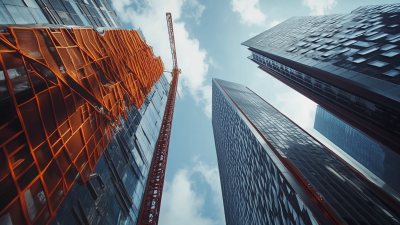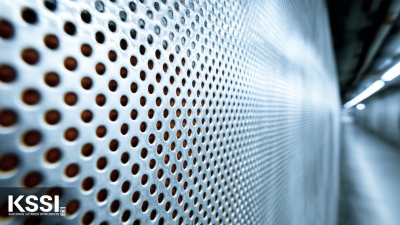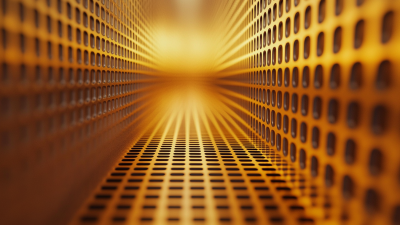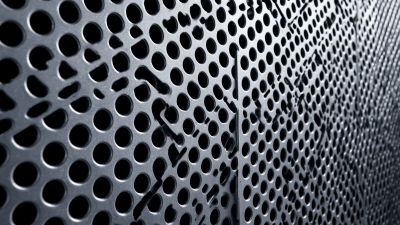In the evolving landscape of modern design, Perforated Sheet Metal Panels have emerged as a versatile solution, enhancing both functionality and aesthetic appeal in various applications. According to a recent report by MarketsandMarkets, the global perforated sheet metal market is projected to reach USD 4.57 billion by 2025, reflecting a compound annual growth rate (CAGR) of 6.2% from 2020. This growth is driven by the increasing demand for lightweight and durable materials in architecture, automotive, and HVAC industries, where perforated sheet metal panels offer improved air circulation, acoustic performance, and visual interest.

As designers and architects continue to seek innovative materials that align with sustainability and efficiency goals, the incorporation of perforated sheet metal panels is revolutionizing spaces by bridging the gap between form and function, thereby making them an indispensable element in contemporary design practices.
Perforated sheet metal, a versatile material in modern design, is defined by its distinctive pattern of holes that can vary in size, shape, and alignment. This unique characteristic not only contributes to the aesthetic appeal of the material but also enhances functionality. The perforations can allow for various effects, including light filtration, sound absorption, and ventilation, making it an ideal choice for applications ranging from architectural facades to interior decor.
The properties of perforated sheet metal extend beyond its visual allure. The strategic arrangement of holes can influence the material's weight and structural integrity, allowing for lightweight designs while maintaining strength. Furthermore, the ability to customize hole patterns means that designers can tailor the material to meet specific design criteria and functional needs, making perforated sheets a preferred option for both public and private spaces. The combination of beauty and practicality makes perforated sheet metal an essential component in contemporary architectural and design practices.

Perforated metal panels are increasingly favored in contemporary architecture not only for their functional benefits but also for their striking aesthetic appeal. These versatile materials allow architects to create striking facades that engage with light and shadow, adding a dynamic visual element to buildings. Their ability to incorporate intricate patterns and designs can enhance the character of a space, transforming ordinary structures into iconic landmarks.

Moreover, the reflective qualities of perforated metal contribute to the overall design ethos of sustainability, promoting energy efficiency by allowing natural light to filter in while minimizing heat gain. This seamless blend of beauty and practicality makes perforated sheet metal an attractive choice for modern designers seeking innovative solutions. Ultimately, the use of perforated metal panels exemplifies a contemporary trend where aesthetics and environmental considerations harmoniously coexist.
Perforated sheet metal panels have emerged as an essential element in modern design, particularly due to their functional advantages in managing sound and light. These panels, characterized by a series of holes or apertures, can significantly enhance acoustic performance by absorbing sound waves and reducing noise levels. This feature makes them ideal for use in environments such as offices, auditoriums, and restaurants, where controlling acoustics is crucial for comfort and productivity. By choosing appropriate hole patterns and sizes, designers can tailor the panels to meet specific sound management needs, fostering a more pleasant acoustic landscape.
In addition to their acoustic properties, perforated panels also play a vital role in regulating light. By allowing varying degrees of natural light to filter through, these panels create dynamic lighting effects while minimizing glare. This adaptability is especially useful in architectural applications where maintaining a balance between illumination and privacy is desired. The ability to control light also contributes to energy efficiency, as strategically placed perforated panels can reduce reliance on artificial lighting. In essence, perforated sheet metal panels are not only aesthetically flexible but also serve as functional elements that enhance both sound management and light regulation in contemporary design landscapes.
| Aspect | Description | Benefits | Applications |
|---|---|---|---|
| Sound Management | Perforated panels can absorb and diffuse sound, reducing echo and noise levels. | Improved acoustic comfort within spaces, ideal for open offices and auditoriums. | Concert halls, conference rooms, and educational facilities. |
| Light Management | Allows natural light to penetrate while reducing glare and direct sunlight. | Enhanced visual comfort and reduced energy costs. | Facades, skylights, and interior partitions. |
| Aesthetic Appeal | Available in various patterns and finishes, enhancing design versatility. | Customizable look that can fit different styles and themes. | Commercial buildings, art installations, and residential projects. |
| Durability | Constructed from sturdy materials that withstand various environmental conditions. | Long lifespan, low maintenance requirements. | External cladding, roofing systems, and industrial applications. |
| Sustainability | Can be made from recycled materials and are fully recyclable. | Reduced carbon footprint and improved environmental compliance. | Green building projects and sustainable architecture. |
Perforated metal panels have emerged as a pivotal element in sustainable architectural design, offering a myriad of environmental benefits. Their unique fabrication allows for improved airflow and natural lighting, which significantly reduces dependency on artificial lighting and HVAC systems. By facilitating better ventilation and eliminating excess heat gain, these panels contribute to energy efficiency, aligning perfectly with the principles of green construction.
Moreover, the versatility of perforated metal panels extends beyond functionality. They can be produced from recycled materials and are 100% recyclable at the end of their lifecycle, thus minimizing waste. The aesthetic appeal of perforated designs also fosters a connection between built environments and their natural surroundings, encouraging biophilic design principles that enhance the well-being of occupants. By integrating perforated sheet metal into modern buildings, architects can create sustainable structures that not only meet practical needs but also promote a greener future.
This chart illustrates the various benefits of using perforated sheet metal panels in sustainable design, highlighting their contributions to energy efficiency, aesthetic appeal, and versatility.
Perforated sheet metal panels are revolutionizing modern design, offering versatility and functionality that seamlessly blend aesthetics with practicality. These panels serve various innovative applications, from striking facades that captivate the eye to intricate interior design elements that enhance spatial dynamics. According to a report by Grand View Research, the global architectural metal and perforated panel market is expected to reach USD 5.5 billion by 2025, underscoring the growing trend of using these materials in contemporary architecture.
On the facade front, perforated panels can create dynamic visual effects while allowing natural light and airflow, contributing to energy-efficient designs. For instance, the perforation patterns can be tailored to optimize performance based on specific environmental contexts, as highlighted in the 2020 Architecture 2030 Challenge which emphasizes sustainable materials.
Inside buildings, these panels are increasingly used in partitioning, acoustic solutions, and decorative features, transforming interiors into functional yet stylish spaces. The ability to customize designs ensures that these elements not only fulfill their practical roles but also elevate the overall aesthetic experience, making them a favored choice for architects and designers alike.






